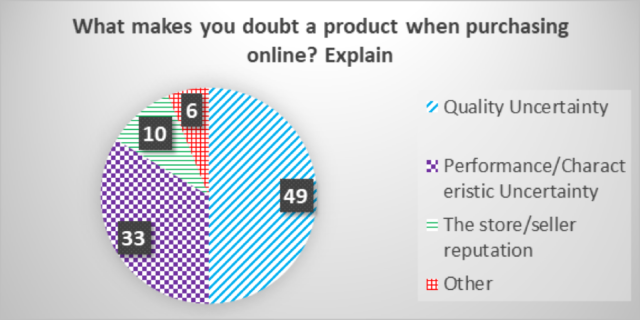Perceived brisk risks in online shopping

In the vast evolving technological development, online shopping behavior has taken the steering wheel into the general business industry. Online shopping trend is projected to have a good growth in the 4-year period (2015-2019) and through the years, it has reached over 100 million customers. By 2020, it is predicted that the number of online consumers will continue to grow up to 119 million people; while in 2015 there were only 18 million people who engaged in the online shopping bandwagon (Fauziah, 2018).
Despite the continuous growth and usage of the Internet as a transaction platform, Indonesian consumers still have their own worries when purchase online. In other words, a lot of Indonesian consumers perceive that there are risks when doing online transactions (i.e. financial risks, physical risks, time risks, product risks, or security risks). These perceived risks might lead into negative attitude toward online shopping such as deciding to avoid online transactions.
Businesses need to focus on what risks customers actually consider before making the actual purchase decisions. Behavior of the customers can be seen along the purchasing funnel, from the landing page, up to the point they reach the shopping carts. Many customers left the shopping cart filled, but they did not make a payment. Analysis should be made along the purchasing process.
To understand more about perceived risk in online shopping, an exploratory study was conducted on 98 respondents in Jakarta. The following is the result of the study.

The highest concern is the quality of the product, followed by performance uncertainty and seller’s reputation. Although product specifications are provided, consumers still have doubts whether the product will perform as promised. Consumers realize that they face product quality uncertainty. There is also concern that the pictures shown in online platform is not depicting the real product. This also includes respondents’ doubts on product’s originality. They simply doubt if the products offered were authentic and original or it’s a fake/knock off product.
There is also a skeptical view when it comes to the product descriptions. Online shopping lacks look-and-feel experience, since consumers cannot physically touch or see the products. This will increase perceived risk. To provide a safety net, consumers reducing their perceived risk by choosing only reputable seller. They felt insecure if the seller is not a ‘star’ seller or sellers who have a high reputation, get some negative reviews from previous customers, etc.
Security concerns becomes another concern. Two themes are coming out from the exploratory study, i.e. fear of personal information misuse and fear of scam and/or fraud. Small percentage of respondents say they have no security issues. This includes credit card information that may be leaking or hacked as well as misuse of shipping and billing address.

A projective test using cartoon test method reveals consumer perception toward time risk in online purchase.

The claim in the conversation bubble above says “I wanted to shop online. But I’m afraid I’m only going to waste my time. What do you think?” Out of 100 responses 72 of them providing responses such as online shopping will save so much more time compared to going to physical stores. However, 13 respondents feel doubtful when it comes to saving time through online shopping, depends on involvement required to do the purchase. The higher the involvement, the more time consuming the process to purchase the product. Some expensive products may require an additional information search in order to find the right brand and the right model that meets the respondents need and some products such as generic product usually does not require a thorough information search as the product is relatively cheap and thus poses a minimum risk towards the respondents in case the product does not meet expectations.
Jakarta consumers have been indulging the online shopping trend since 2016 and have reached 1.2% of its consumers and it is predicted to grow up to 5.4% in 2030. While the traditional physical market will experience quiet a downfall from 56.3% in 2016 to 46.6% by the year 2030 (Ayuwuragil, 2018). Furthermore, it is stated that two out of five Indonesians is believed to ‘spot a good offline and purchased it online’. This is very positive to the growth of online shopping, and perceived risks should not hinder them to complete the purchase. As studies found significant relationship between perceived risk and online purchase intention, risk mitigation efforts is mandatory. Actions and tactics that can reduce perceived risk while increasing seller’s reputation need to be openly communicated (through forums, chats, badges, stars, and any other tools).
Dr. Evi Rinawati Simanjuntak
Business Management and Marketing
BBS – IUP
(Students in Business Management and Marketing – International Undergraduate Program will learn relevant topics on market research under the course: Research Methods in Marketing. Visit our Business Management and Marketing curriculum to know more.)
References:
Ayuwuragil, K. (2017). 2 dari 5 Orang Indonesia Lihat di Toko, Lalu Beli ‘Online’. Retrieved from cnnindonesia.com: https://www.cnnindonesia.com/teknologi/20171213073636-185-261997/2-dari-5-orang-indonesia-lihat-di-toko-lalu-beli-online
Fauziah, S. (2018). Tren belanja online diprediksi makin meningkat hingga 2030. Retrieved from brilio.net: https://www.brilio.net/ekonomi/tren-belanja-online-diprediksi-makin-meningkat-hingga-2030-180910b.html#
